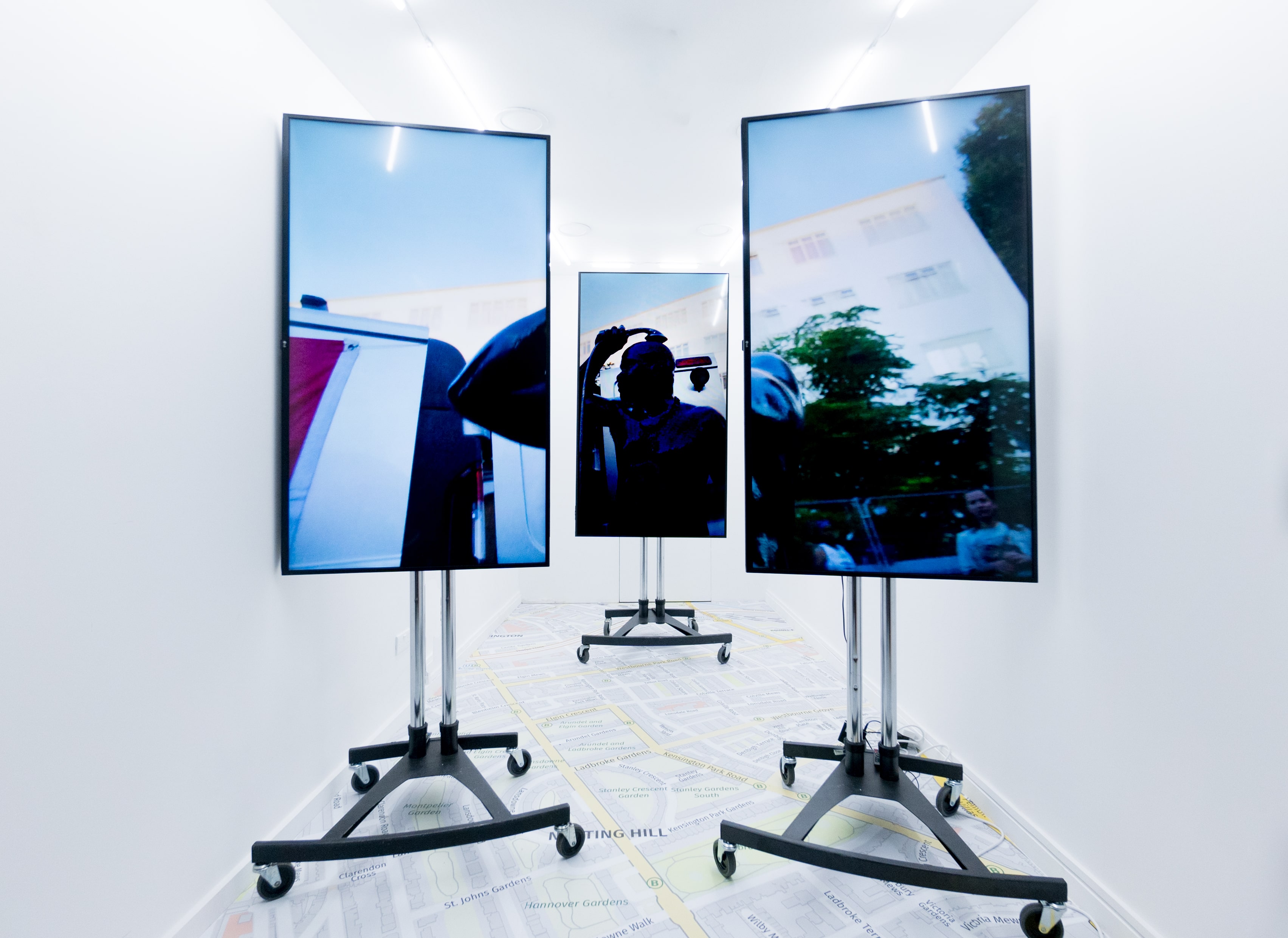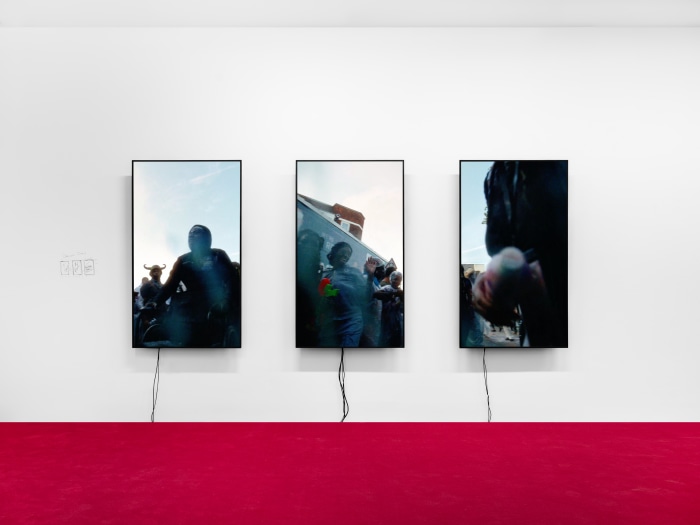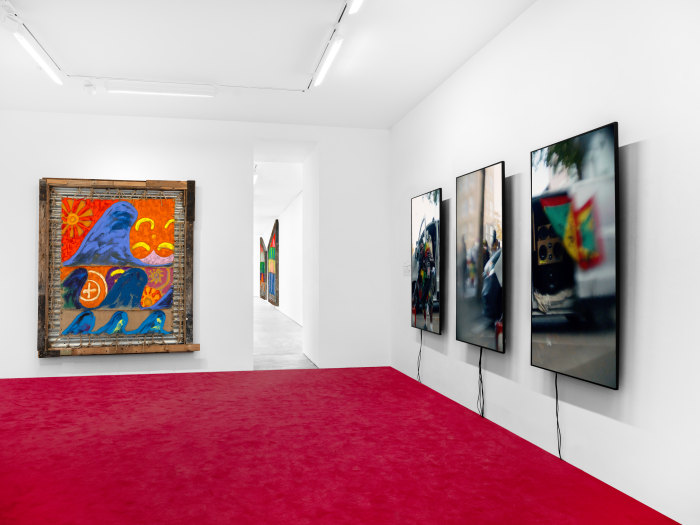 TABANCA
TABANCAAkinola Davies Jr.
Running time: 16 mins 16 seconds (approx)
Private View: 4 December 23 6-9pm
6th December 2023 - 27 January 2024
Open Wednesday - Saturday 12-5pm
And by appointment
Book here for appointment
A tilted Trellick tower, announced by blowhorn, welcomes us to West London. The clarion call distorts, panning to disciples dedicated to dance. The camera lens gazes briefly, like a passing sunray, capturing a defiant joy, 'a sorrow unmasked'.
We have arrived at Notting Hill Carnival: an absolution to the 1958 Notting Hill race riots and celebration of All Saints Road: the nexus of London’s Afro-Caribbean community. Following the arrival of the ship SS Empire Windrush in 1948, the bourgeoning West Indian community was met with hostility from Teddy Boy gangs and Oswald Mosley’s far-right Union party, who attacked London’s Black communities.
The West Indian community resisted, with Claudia Jones initiating Carnival and civil rights activist Frank Crichlow establishing The Mangrove, a Caribbean restaurant serving edible and political nourishment to the local community between 1968 and 1992. Racial hostility pervaded, including police discrimination. The Afro-Caribbean community resisted through protest.
Their protest for the right to own and demarcate an Afro-Caribbean space without suspicion was misconstrued as a riot. That riot was reclaimed as Carnival: a declaration, an expression, a disruption. Carnival usurped riot; riot transformed to celebration, "a freedom to celebrate who we are, the culture that we brought to this country".
Alvaro Barrington invited filmmaker Akinola Davies to make a visual reflection of Carnival, wanting to "capture Carnival, from inception to end". The film is unsettling as much as it illuminates; it articulates a saturated, effervescent, and dense spirit: a sensory overload.
The visuals of the crowd are hypnotic; it's easy to get lost, as you would at Carnival.
It is an immersive and provocative meditation, asking who Carnival continues to belong to.
Regardless of ownership, a crowning shot of a man raising a wheelchair to the sky as if he were Rafiki christening Simpa illustrates how liberating Carnival can be.
We glide through miscellaneous bodies in movement, a community holding onto to their heritage, a tradition that is both heralded yet navigating precarity each year, "it used to be 24 hours, then it stopped at midnight, then ten, then eight and now seven, it's closing earlier and earlier".
The streets are strewn with relics of recent jubilation: bottles, balloons, tassels, and the glow of languid yellow polystyrene takeaway trays. By the end of each August weekend, the streets are swept clean, ushering in Tabanca, 'a depression after Carnival, a Trini word everyone gets, the comedown from Carnival'. A 'mourning that the two days are gone, and the beginning of the preparations for next year'. Carnival is a portal that transports the local community back to Caribbean islands abstracted through time. It manifests through a weekend of escape set in a community fighting to remember history through its diaspora living in London.
Blessings to Coby Sey for the musical score and CJ Mirra for sound design, with additional sounds from James Massiah and Lord Tusk.
Text by Bianca Manu
Akinola Davies Jr. (London, 1985; lives and works in London, England) is a multi-disciplinary filmmaker, writer and video artist. Davies was awarded the 2021 Sundance Grand Jury Prize for his debut short film ‘Lizard’ and was also nominated for Best British Short Film: 2021 BAFTAS. Alongside his narrative practice, he works to repurpose archives and establish dialogues in diverse communities, including (but not limited to) Northern and Southern Nigeria, Ghana, UK and USA.
Davies practice celebrates marginalised communities, particularly the most disengaged, prioritising these discourses by building bridges between elder and younger generations and re-establishing ancestral dialogue. He is dedicated to honouring the stories of the foremothers and fathers of these communities whilst learning from younger generations. His approach is intergenerational, focused on memory and oral tradition, and seeks to translate these histories and lived experiences into the moving image.
Exhibition Images



TABANCA
Akinola Davies Jr.
Running time: 16 mins 16 seconds (approx)
9:16 3.8k video Installation on screens measuring at 65 inches, 75 inches and 65 inches (from left to right)


Selected Press
Another Magazine by Koye Odenjinmi
Sadie Coles Initial installation


